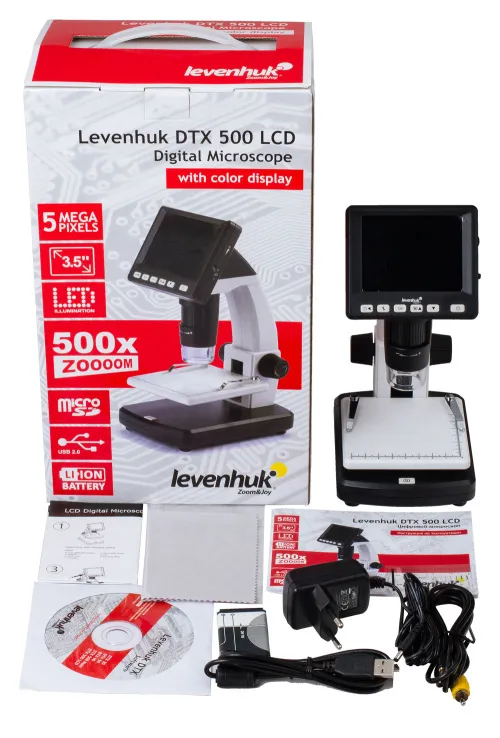Levenhuk DTX 500 LCD- Exhibition Item
USB digital microscope with LCD display. Magnification: 20x, 200x, 500x. Digital camera: 5Mpx
| Product ID | 76773 |
| Brand | Levenhuk, Inc., USA |
| Warranty | lifetime |
| EAN | 2400000044956 |
| Package size (LxWxH) | 20x14x33 cm |
| Shipping Weight | 1.4 kg |
Special price! Further discounts or special offers cannot be applied in this case.
Exhibition copy.
This product looks lightly used.
Otherwise, the product is fully functional.
Exhibition copies cannot be exchanged or returned for a refund. Levenhuk DTX 500 LCD Digital Microscope with built-in 3.5-inch LCD display allows you to study samples under magnification of 20x to 500x and save results of your work in image or video format to a microSD card. 8 built-in LED lights evenly light the working surface and ensure minimal energy consumption. The illumination system also features a brightness adjustment. The stage of this microscope is equipped with a measuring scale (8 cm along the x-axis, 6 cm along the y-axis) and two clips to secure the sample under the camera. The high-quality LCD panel provides crystal-clear images and has buttons that allow you to quickly change brightness, exposure and color balance. You can easily connect the Levenhuk DTX 500 LCD to your PC using the USB cable included in the kit and copy all the files created during your observations to your hard drive. This amazing model also features an AV output to transfer observed images to a TV screen or projector in real time. Levenhuk DTX 500 LCD Digital Microscope is powered by the Li-ion battery included in the kit, which provides for up to 2 hours of standalone work. The microscope may also be powered via the USB port of your PC. Features: The kit includes: Recommendations on using the software: In order for the program to operate correctly, please launch the installed application only when your microscope is connected to a PC and ready for observations. Levenhuk DTX 500 LCD Digital Microscope is not compatible with external digital cameras. Caution: Please refer to the specifications table for the correct mains voltage and never attempt to plug a 110V device into 220V outlet and vice versa without using a converter. Remember that mains voltage in the U.S. and Canada is 110V and 220–240V in most European countries.
| Product ID | 76773 |
| Brand | Levenhuk, Inc., USA |
| Warranty | lifetime |
| EAN | 2400000044956 |
| Package size (LxWxH) | 20x14x33 cm |
| Shipping Weight | 1.4 kg |
| Type | digital, portable |
| Microscope head type | digital screen/PC monitor |
| Optics material | optical glass |
| Head | 3.5" color LCD screen (fixed) |
| Magnification, x | 20 — 500 |
| Focus | manual, 0–150mm |
| Illumination | LED |
| Brightness adjustment | ✓ |
| Power supply | 100–240V, 50/60Hz; 5V, 1A outlet |
| Power supply: batteries/built-in battery | Li-ion battery 3.7V/1050mAh; operating time: 2 hours, charging time: 2 hours |
| Ability to connect additional equipment | supports microSD memory cards up to 32GB (not included) |
| Image | *.jpeg |
| Application | for applied research |
| Illumination location | upper |
| Research method | bright field |
| Maximum resolution | 12MP, 8MP, 5MP, 3MP, 1.3MP, VGA |
| Megapixels | 5 |
| Megapixels | 5 (with interpolation up to 12) |
| Video recording | yes |
| Video format | *.avi |
| Frame rate | 30 frames per second |
| Software, drivers | photo and video capture and processing software with measurement function |
| Output | USB 2.0 |
| System requirements | OS Windows 7/8/10, Mac 10.6 ~ 10.10; 1.8GHz Intel P4 and above, 512MB RAM, 64MB video card, USB 2.0, CD-ROM |
We have gathered answers to the most frequently asked questions to help you sort things out
Find out why studying eyes under a microscope is entertaining; how insects’ and arachnids’ eyes differ and what the best way is to observe such an interesting specimen
Read this review to learn how to observe human hair, what different hair looks like under a microscope and what magnification is required for observations
Learn what a numerical aperture is and how to choose a suitable objective lens for your microscope here
Learn what a spider looks like under microscope, when the best time is to take photos of it, how to study it properly at magnification and more interesting facts about observing insects and arachnids
This review for beginner explorers of the micro world introduces you to the optical, illuminating and mechanical parts of a microscope and their functions
Short article about Paramecium caudatum - a microorganism that is interesting to observe through any microscope














